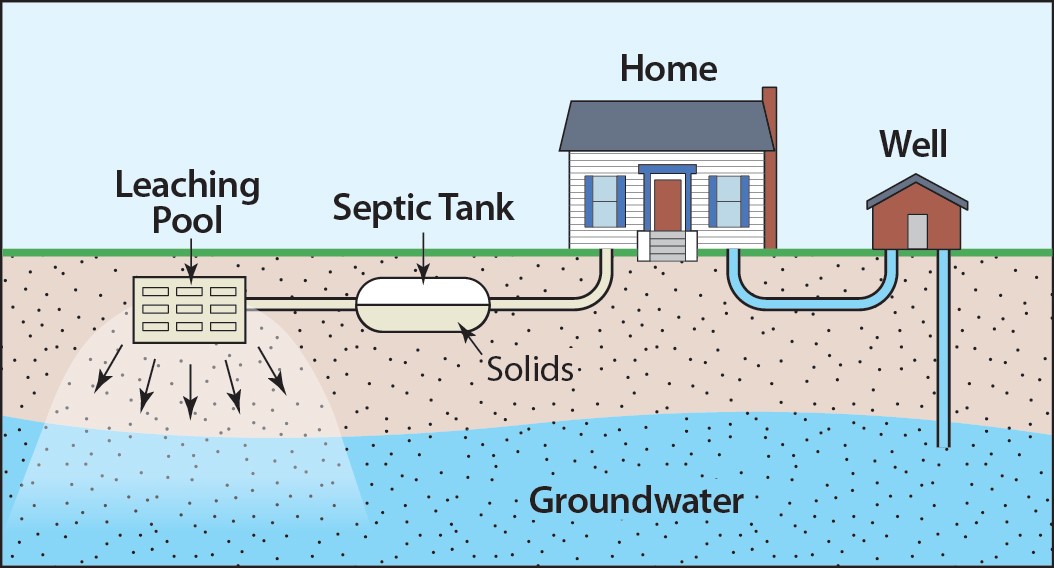1. Upgrade your septic system and support installing a Village sewage treatment plant.

Southampton’s antiquated septic systems, its lack of a central village sewer, and outmoded residential septic systems, are the root causes of the harmful algae blooms that plague Lake Agawam and thus all our water. According to Dr. Chris Gobler of Stony Brook University’s Center for Clean Water Technology (CCWT), around 70% of nitrogen entering Lake Agawam comes from wastewater from Southampton homes and businesses throughout the two mile watershed. It is urgent that our leaders find a location for a central village sewer and install one. For anyone with a septic system that
predates 1973, your septic is essentially a cesspool, directly leaching wastewater into all our groundwater, contaminating the lake, ponds, bays and ocean. For all homes, Innovative and Alternative (I/A) systems that remove nitrogen before releasing it are recommended. The difference between post 1973 conventional sanitary systems and the new I/A systems is that the I/A technology reduces nitrogen outflow by 65%! That’s a huge impact per home. There should be a law requiring septic upgrades upon sale. If you have any questions, feel free to reach out to Thomas Varley, Watershed Manager for the CCWT, at thomas.varley@stonybrook.edu or Bridgewater Environmental Services https://www.bridgewaterenviro.com/contact-us/.
2. Stop using fertilizers, especially synthetic ones, and pesticides on your property.
Many commercial landscape fertilizers and pesticides contain toxins that can release harmful vapors into the air and seep into the ground polluting our precious resource – clean drinking and swimming water. Synthetic fertilizers commonly used on lawns and landscapes also contain high concentrations of nitrogen and phosphorus, the two elements most responsible for causing harmful algal blooms in our local lakes and ponds. Here are some tips to maintain a landscape without synthetic fertilizer and harmful chemicals. Seed different types of turf grass into your lawn to foster a resilient mix of grasses, use compost tea as a fertilizer and soil booster, and allow clover to coexist in your lawn – it fixes nitrogen from the air and puts it in the ground and naturally fertilizes grass. In flower beds, plant a variety of natives that do not require chemical inputs to thrive. In the autumn mow fallen leaves into the lawn – as they decompose they provide natural fertilizer. For more, contact The Perfect Earth Project https://perfectearthproject.org/.
3. This November, vote “Yes” on Southampton Town’s Proposition to help clean the Lake.
On Tuesday, November 5th, there will be a proposition on the back of the ballot asking all Southampton Town voters if a portion of 43 South Main Street can be used for an important water quality project to place an algae harvester to filter the harmful toxins from Lake Agawam. Since the entire town of Southampton contributes to the
Community Preservation Fund (CPF) and can access Lake Agawam, everyone here has a say. In exchange for allowing the harvester to be placed at 43 South Main Street (69,989 sq. ft. in area), the Town will purchase 137 Pond Lane (209,864 sq. ft. in area) and dedicate it as additional parkland. This is more open space adjacent to other CPF properties. Once the algae harvester is removed, the land will still be publicly owned and utilized as parkland. It is a win-win! People who care about the environment are voting “Yes” on this important ballot proposition, you should too!
What will the algae harvester do?
- It can filter algae out of 3,000,000 gallons of lake water per day running 24/7.
- As the lake gets cleaner, running time can be dialed back.
- We should see results within six months.
- By the second year of operation we should see a significant drop in the algae load.
- By the third year the lake should be considered safe for recreation.
Where will the water for the harvester come from and where will it be released?
- Contaminated water will be drawn from the north end of the lake.
- The clean water will be discharged in the south end of the lake.
- Added environmental benefit: because the lake is periodically drained from the south end to control the water level, the discharge going into the ocean will be cleaner.
Will the harvester have any other impacts on the Village?
- The new plan eliminates dewatering, thus eliminating any odor.
- The noise level is about the same as an A/C unit: 50db @ 10 feet.
- A 3,000 to 5,000 gallon “water” truck will make one trip daily to remove harvested algae, taking less than an hour to load and leave.
- All piping and pumps will be underground or underwater, generating no noise.
- Only thing visible from the lake will be a normal dock.

